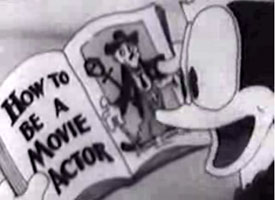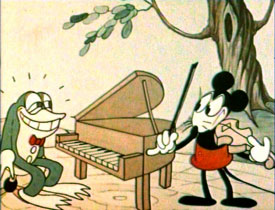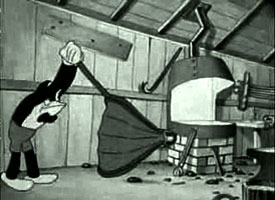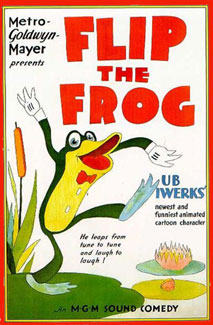 I started watching a dvd set of Flip the Frog & just never got through it. He simply wasn't coknnecting with me as an interesting character, & much as I love vintage cartoons, there are thousands of good ones yet to see, so I stopped watching Flip. I started watching a dvd set of Flip the Frog & just never got through it. He simply wasn't coknnecting with me as an interesting character, & much as I love vintage cartoons, there are thousands of good ones yet to see, so I stopped watching Flip.
I'll describe those I did watch, however, & try to be fare in my assessments. Flip's career lasted from 1930 to 1933. Flip was the first regular character at Ub Iwerks' newly established animation studio, with an M.G.M. contract for theatrical distribution.
Flip the Frog in Movie Mad (1931) is reading up on "How To Be A Movie Actor." He momentarily transforms into Charlie Chaplin while walking down the street. He tries to sneak into a movie studio but the guard keeps tossing him out.
An Oliver Hardy pig & Stan Laurel dog are filming a kitchen scene that turns into a pie-throwing battle, & one of the pies wacks the doggy guard who is chasing Flip. Flip runs into another set & ends up in a western shoot-out thinking it's real.
A standard "in & out of many doors" scene follows that has nothing to do with the overall theme. The most interesting thing about it is how old this gag really is, it having recurred in everything from Yellow Submarine to South Park pretty much exactly as shown here.
Flip disguises himself as an Arabian Knights maiden & the guard gets a crush. "She" tosses him a rose which has a bee in it, which stings his nose. Flip then gets caught up in a film set with a sultan, doing a belly dance as Fatima. Another set lands him in a romantic scene with a pretty kitty. At last the guard catches him & tosses him out yet again.
 Two-strip Techicolor Flip the Frog stars in Fiddlesticks (1930). This was Flip's very first starring vehicle, though creator Ub Iwerks had previously drawn the character while working with Walt Disney, in the final Silly Symphonies episode entitled Night (1930). Ub left Disney's employ & continued to use the character at Celebrity Productions.
Two-strip Techicolor Flip the Frog stars in Fiddlesticks (1930). This was Flip's very first starring vehicle, though creator Ub Iwerks had previously drawn the character while working with Walt Disney, in the final Silly Symphonies episode entitled Night (1930). Ub left Disney's employ & continued to use the character at Celebrity Productions.
This was M.G.M.'s first sound cartoon. It was also the very first full-length full-color commercial cartoon, so it made quite a splash. Despite Flip's color debut, the rest of the Flip cartoons would be black & white with only one exception toward the end of his run, Techno-Cracked (1933).
Flip is pretty much the same design as would be adapted for the famous Warner Brothers One Froggy Evening (1955), morphing Flip into the jazz singer Michigan J. Frog. Later on, at M.G.M.'s insistence meant Flip would change to be less & less obviously a frog (except on the title card at the start), but in the premiere film his is the same design borrowed by Chuck Jones.
Following the pattern of Silly Symphonies, Flip hops into a region of the swamp where all the insects have gotten together to form an orchestra. He strolls out onto a smoothly sawn stump & does dramatic tapdance while croaking more like a duck than a frog.
Next Flip plays piano with a fiddling Mickey Mouse, or a clone thereof. Walt Disney was notoriously protective of the Mickey character but where Ub was concerned, Ub used Mickey without risking trouble. Some animation historians are convinced Walt had no choice but to grant special dispensation to Ub, who may well have had as much to do with Mickey's design as did Disney.
 The Soup Song (1931) is built around a musical score by Carl W. Stalling, the most famed of cartoon tunesmiths. It's a jive-hoppin' night at the cafe down the road (really a tavern cabaret).
The Soup Song (1931) is built around a musical score by Carl W. Stalling, the most famed of cartoon tunesmiths. It's a jive-hoppin' night at the cafe down the road (really a tavern cabaret).
An animal orchestra is playing with Flip the Frog the band leader. He joins the singing chorus amogn the musicians, every animal singing lyrics simultaneously in their own "languages," cat's meow, Flip's "boop," pig's snort, & so on. A choras line of pretty kitties dances center stage.
Flip also does double duty as the waiter & cook. His recipe for making a soup includes dipping a boot & a plucked chicken momentarily in the pot. The chicken regains consciousness, alarmed to find itself plucked.
There are lots of restaurant gags, such as a dog patron so impatient waiting for Flip to deliver a meal (Flip's too busy flirting with one of the kitties) & so eats his place setting.
The last of the minor gags is Flip conducting the patron who whistles "Auld Lang Syne" while sipping soup.
 Flip the Frog in The Village Barber (1930) puts out his barber pole &ajmp oils the live beetles in the turning mechanism.
Flip the Frog in The Village Barber (1930) puts out his barber pole &ajmp oils the live beetles in the turning mechanism.
A passing fat pig mistakes the pole for a candy cane & carts it away to eat. So Flip starches a striped cat's tail, tears the tail right off, & has himself a furry barber pole.
A very hairy dog comes in for a haircut & a full body shave, rendering some fleas homeless. A duck gives the customer a manicure. A cat shines his shoes. A goat meanwhile puts a coin in the player piano & a spider jumps out & plays it, joined by a fly whose added playing annoys the spider.
Daisies dance in their flowerpots in the window. The pot belly stove dances to the spider's piano playing too. The duck, cat, Flip the Frog, & dog client conclude with a barshop quartet performance of animal noises. It's just your average lively day at Flip's barber shop.
 This time Flip the Frog tries his hand at being a blacksmith in The Village Smitty (1931). There are a few barnyard gags with the animals around the smithy barn, & a lot of blacksmith gags.
This time Flip the Frog tries his hand at being a blacksmith in The Village Smitty (1931). There are a few barnyard gags with the animals around the smithy barn, & a lot of blacksmith gags.
Along comes a maidenly cat in a horse-drawn cart, with a basket of ducks. The horse throws a shoe so they limp into the smithy barn.
The horse is impatient for his new shoe as Flip dawdles flirting with Kitty. The gags are such as Flip falling in the fire, running about yelling "Fire!" until the horse spits a chaw of tobacco at his rear end to put him out.
To the beat of Flip's bellows, Kitty sings, "Oomp pah, oomp pah, boop-oop-a-doop" in imitation of Betty Boop, then begins playing the handy pump organ such as every smithy keeps about.
A blowfly comes in the window, sharpens its snout on a millstone, & stabs the horse, which runs off at full tilt with Kitty riding out of countrol yelling "Help! Help!" When saved Kitty squeeks out, "My hero." We may suppose they raised a weird little deformed cat-frog together.
 "Boy Wanted" says the sign on the door of Screw Nut & Bolt Co. Soon Flip the Frog becomes The Office Boy (1932).
"Boy Wanted" says the sign on the door of Screw Nut & Bolt Co. Soon Flip the Frog becomes The Office Boy (1932).
Office worker gags abound, beginning with getting a cat to lick the awful tasting envelopes. Office work in those days apparently included washing windows & general janitorial services.
The office has a Victorola which gets Flip & the flapper secretary into a dancing mood. One of Ub Iwerk's animators was Grim Natwick who created Betty Boop for Fleischer Studios & shows some of the same tendency in flapper designs for Ub's studio.
In these pre-code days risque gags were common. When the cat takes off after a mouse, the mouse jumps up on the flalpper secretaries skirt & she gets red-faced. The cat then rubs its fur the full length of her crotch, & she passes out from the excitement & Flip has to rouse her to consciousness. She'll soonafter get her skirt ripped off by a fan.
Finally flip joins in the rat-catching escapades & ends up wrecking the whole office. in the end the secretary quits & Flip is fired.
copyright © by Paghat the Ratgirl
|






